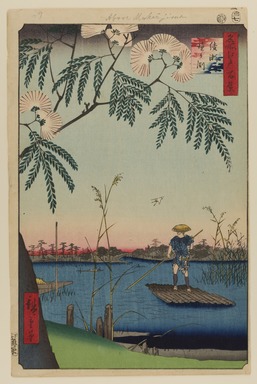
Artist:Utagawa Hiroshige
Medium: Woodblock print
Geograhical Locations:
Dates:7th month of 1857
Dimensions: Sheet: 14 1/4 x 9 5/16 in. (36.2 x 23.7 cm) Image: 13 3/8 x 8 3/4 in. (33.9 x 22.2 cm)
Collections:
Exhibitions:
Accession Number: 30.1478.63
Image: 30.1478.63_PS20.jpg,
Catalogue Description: This view looks at the point where the Ayase River flows into the Sumida; due to its curve and convergence with the Ayase, the water here was deeper and the flow more rapid than elsewhere on the Sumida. The story is told of a temple bell which fell into the river during a flood, sinking to the bottom and giving the name Kanegafuchi, "bell depths" for the stretch of the river. This location was also known for its silk trees, a kind of mimosa, growing along the bank. This scene shows one of the trees in full bloom with its silk like pink flowers accented in black. The boatman below is dressed in a bold patterned garment and a heron flies above the reeds. In 1887 the Kanegafuchi Spinning Company was constructed on the south bank of the Ayase River (the area to the far right), a joint venture of five Tokyo cotton-thread dealers, known as "kanebo." In time it became Japan's largest cotton-spinning firm and has since diversified into cosmetics.